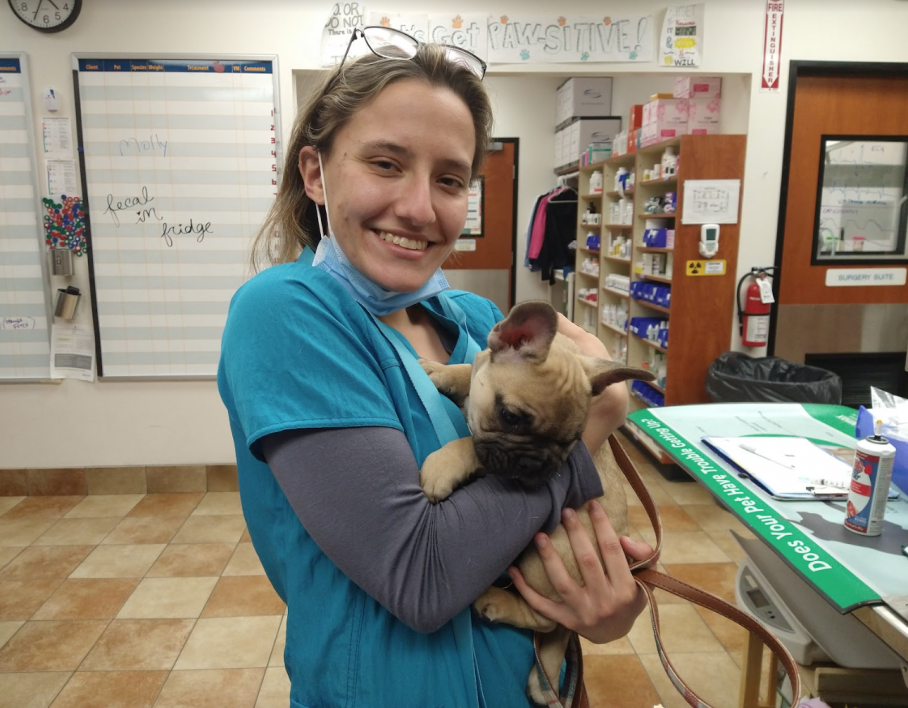ASU pre-veterinary medicine student cares for animals on Navajo land

Jennifer Kobs (right), a senior applied biological sciences major and pre-veterinary medicine student, helps with surgery on a canine patient at the GoPawesome spay and neuter clinic in Gallup, New Mexico, held June 15–17.
For Jennifer Kobs, an Arizona State University applied biological sciences senior, two days in June were intense, tiring and fulfilling as she helped spay and neuter animals on the Navajo Nation in northern New Mexico.
Kobs, a Barrett, The Honors College student whose focus is on pre-veterinary medicine with a certificate in wildlife management, participated in the GoPawesome Spay & Neuter Surgical Instruction and Training Course in Gallup, New Mexico, on June 15–17. Barrett Honors College provided funding for Kobs to participate in the program, which was held in a school gymnasium set up with surgical tables and other equipment.
The program is an intense, two-day surgical training course that provides veterinary students at all levels the opportunity to gain spay and neuter experience as they work alongside licensed veterinarians who are working to improve their skills and gain surgical time.
It also provides much needed veterinary care for dogs and cats on Navajo land in the Four Corners region of northern Arizona, New Mexico, Utah and Colorado. In addition to spay and neuter procedures, the program offers vaccines and treatment for fleas, ticks and worms.
Program participants work with GoPawesome’s veterinarians, who are skilled in high-volume spay and neuter techniques, and are assisted by veterinary technicians.
“This was my first high-volume experience, so I was unsure of what the clinical environment would be like. I initially was scared and nervous to participate, as I did not know how hands-on I would be getting,” said Kobs, a first-generation student from Santa Fe, New Mexico.
As it turned out, she got lots of hands-on experience as she assisted with surgeries throughout a packed schedule on both days.
“On the first morning, our day started at 5 a.m. Travel time to the clinic was an hour and a half, and we began the clinic setup at 7:45 before we began surgery by 9:30 a.m. From that moment, we were working our shifts, nonstop, until our last surgeries at around 6 p.m.,” Kobs said.
Kobs was assigned to different positions and tasks focused on skill sets within a high-volume spay and neuter veterinary clinic.
In the “prep” area, she helped with surgical preparation, which included injecting medications like antibiotics and pain killers, catheter placement, intubation and shaving the surgical site.
While assisting with anesthesia, she was responsible for ensuring proper operation of the anesthesia rebreathing and non-breathing system, which including checking the flow lines and weighing the gas waste canisters after each patient. Other tasks included confirming the proper flow of isoflurane, a general anesthetic, and checking vital signs.
Jennifer Kobs aims to become a veterinarian working with animals at a zoo or wildlife sanctuary. Photo courtesy Jennifer Kobs
She also directly assisted with surgeries by passing instruments to the doctor, scrubbing the surgical site and ensuring surgical sterility. She learned surgical processes and techniques, and practiced suturing under a doctor’s supervision.
“This was arguably the most stressful and exciting part of the experience, as I was able to assist with the surgeries directly,” she said, adding that she learned the anatomy of the reproductive organs and the surgical steps necessary for spaying and neutering in order to avoid future litters of feral cats and dogs.
“The anesthesia was the most challenging part of the experience on both days, due to the nature of this position, as the doctor is relying on you to read the proper cues (bodily movement, pupillary response, etc.) to ensure safe anesthetic administration. By the end of the experience, I had placed seven to nine catheters and I assisted in over 10 surgeries, which was far more than I was expecting to practice within two days. I thoroughly enjoyed this program, but I would only recommend it to pre-vet students who have had prior experience with anesthesia or surgery, due to the intensity of the environment,” Kobs said.
Kobs said her goal is to attend veterinary school and work in general practice at a zoo or a wildlife sanctuary. She also is interested in providing at-home euthanasia services for pets who are at the end of their lives.
“GoPawesome helped me step outside of my comfort zone in a new program that focuses on medicine I haven't been able to practice yet, and allowed me to gain further experience that I will ultimately build upon in the future,” she said.
More Science and technology

How AI is changing college
Artificial intelligence is the “great equalizer,” in the words of ASU President Michael Crow.It’s compelled industries, including…

The Dreamscape effect
Written by Bret HovellSeventh grader Samuel Granado is a well-spoken and bright student at Villa de Paz Elementary School in…

Research expenditures ranking underscores ASU’s dramatic growth in high-impact science
Arizona State University has surpassed $1 billion in annual research funding for the first time, placing the university among the…
